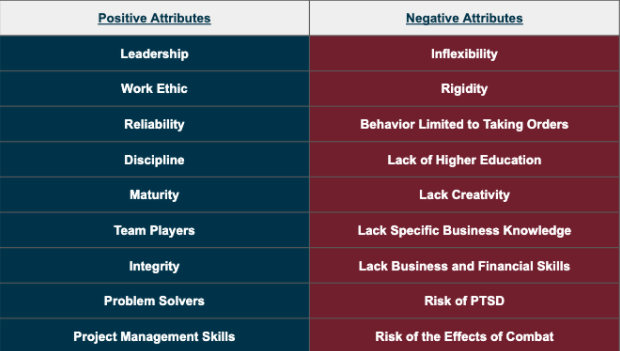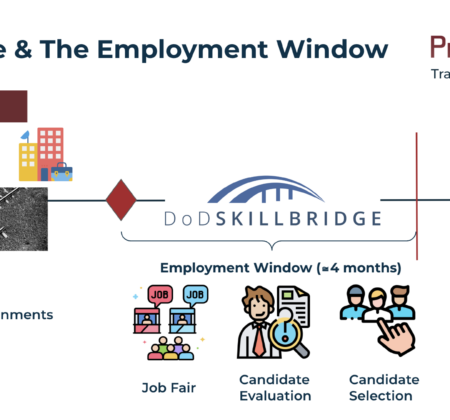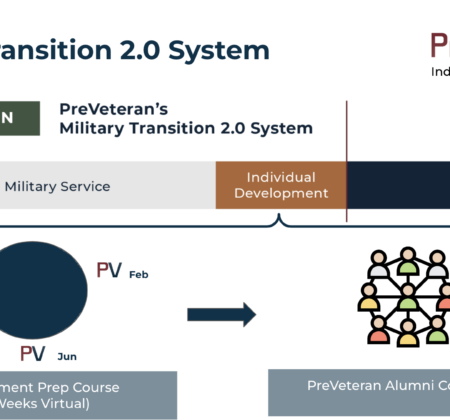If you are a military member or military spouse, there are two important things you need to know about your military transition.
- There is a 100% chance you will depart the military. Rarely in life can you be so sure about anything.
- In order to have a successful military transition, you need to self-transform—the earlier the better.
Here is what I mean by self-transformation. Regardless of your branch of service, you entered the military training pipeline as an individual U.S. citizen. Through very deliberate training and repetition, you were transformed from that individual U.S. citizen into a soldier, sailor, airman, or Marine.
When you completed your initial training, you entered the broader military ecosystem and became a part of the military community. As you can see from the graphic, this explains the “input” side of the equation. If there is an input, there is also an eventual “output.”
Once you complete your military career, you exit that military ecosystem and return to being an individual. If only it were that easy!

In reality, there are a couple phenomena at play that make this transition very challenging. First, you are transitioning from a very homogenous military ecosystem to a much less homogenous—and significantly more diverse—general population. And second, companies in the private sector live in a different reality.
To put this environmental change in context with numbers, population-wise the active duty component (including the guard and reserve) represents less than 1% of the U.S. population. As the U.S. population continues growing, that percentage continues to shrink. So, proportionally, this segment of the population—military members—that you have the most affinity with is extremely small. As a veteran, that segment grows to 7% of the overall population but is also decreasing over time.
So, from this perspective, you are reentering the general public within a very small minority. “So what?”, you may be thinking to yourself. And in many respects, you are correct to ask. After all, you are just another American reentering the general population and workforce, right?
Well, yes and no. Yes, you are an educated, well-trained, and experienced American reentering the general public and workforce. However, many of your military-related experiences create a misalignment with the private sector.
An example of misalignment are your military employment-related experiences and how the free-market private sector functions. When you entered the military, you were tracked and trained into a specific Military Occupation Specialty Code (MOS) or Air Force Specialty Code (AFSC). While that employment track is certainly specialized, once you went off to your unit, you likely filled the role you were trained for in addition to numerous additional duties you were “highly encouraged” to take on.
Living in this environment—helping the unit wherever needed—has deliberately contributed to your belief that organizations value a “generalist” who can grow where needed and fix problems.
While this is true in the military ecosystem, it is significantly misaligned with how private sector businesses conduct business and hire talent.
Companies within the private sector deal with a different reality. There is no government mandate for them to exist. Instead, they must create a product or service so valuable to consumers that they voluntarily reach into their pockets and provide them money.
From a practical standpoint, this means that these businesses are exceptionally detailed about their approach to business—right down to the specific employee they need, with an equally specific skill set, to fill a very specific role in their operations.
In other words, the two worlds could not be any more different. Which brings us back to self-transformation. To be successful after the military, part of your self-transformation must include understanding these key differences between the two systems. From the outset, if you don’t understand these differences, you will be constantly trying to fit yourself into an environment that values different things for different reasons. More importantly, despite your talents and personal attributes, you will spend a lot of time and effort trying to apply your skills in a non-aligned manner—the proverbial trying to fit a square peg into a round hole—all the while spinning your wheels, wasting valuable time and energy, and making little progress.
If you are reading this blog or listening to this video, you might be thinking to yourself, “Well yes, this makes sense, but why haven’t I heard it put this way before?” To answer that question, we need to look at the existing transition system and some of the associated research that influences how policy makers approach and think about you as you begin preparing for your transition.
Obstacles to Your Self-Transformation
First, through firsthand experience or through conversations with your coworkers, you’ve probably heard about the existing transition system. By law it covers a wide variety of information applicable to everyone. This means you have to sit through hours of material that may or may not be useful to you and what you want to do following your departure from the military.
The crux of the problem is that the system is one-size-fits-all, but that is not the only problem. Another problem rests on how outside research has shaped the way policy makers look at and think about the transitioning military population.
Here is one example of how early research has shaped the military transition system in a way that is counterproductive to helping military members be successful.
Let’s take a look at a 2008 VA-funded study. At the time, it was the most comprehensive and robust study created for military transition because its multiple data sources spanned the 1991–2003 time period. In fact, it remains one
of the larger VA-funded studies to this day.
In this particular study they took data from two different sources. First, they did a survey of 1,941 recently separated service members (RSS). Second, they conducted seven corporate visits and six peer-to-peer consultations with senior executives, talent acquisition managers, and human resource (HR) directors at a variety of large companies spanning various markets, products, and services.
The study format asked eight questions and provided recommendations. Check out question number seven.
Question 7: How might the promotion of the merits of recently separated service members to business leaders improve private sector employment opportunities?
The study went on to mention that, in those interviews the interviewees—senior executives, talent acquisition managers, and HR directors—consistently communicated the following positive and negative perceptions about the RSSs as potential job candidates.

Now, if you are a military member and are reading this list, it might sting a little bit—or a lot. I know it did for me when I found this article early in 2015 as part of my research into military transition.
At first, I felt good about the positive attributes and was pissed off about the negative attributes. How dare they!? However, after taking some time and really being honest with myself, a majority of these negative attributes looked very accurate. The only exceptions being: lack of higher education, risk of PTSD, and risk of effects of combat, where I think their perceptions completely miss the mark and are not supported by the data.
Here is precisely where things go off the rails—the researcher’s recommendation—and why this recommendation is not good for you or anyone departing the military.
Researcher answer (and recommendation): “In order to promote the merits of RSS to business leaders, the brand will need to emphasize the positive attributes and correct the misconceived negative attributes.”
Whoa—hold on a second. Read that one more time.
Did they just summarily label negative attributes provided by a host of executives, hiring managers, and HR directors as misconceived? These are, after all, the people who will be hiring you, right?
Might you want to know their honest thoughts? Anytime researchers recommend withholding information or not addressing real concerns—even if it stings—shields you from knowing and addressing real concerns actual employers have verbalized when asked to think about transitioning military members they want to hire.
Good Intentions Gone Wrong
Again, this is one data point. However, from doing extensive research in this space, it set a baseline narrative that’s been subsequently repeated over the years—transitioning military need not change but the general public and employers need to change to accommodate the military members.
While I get the intent, is this system-wide advocacy really befitting you and your family at all? The answer is an obvious no. In fact, it’s hurting you.
What should have happened is the researchers and the government should have treated you as the adults that you are to have that discussion on their impressions. After all, they are the ones who are hiring you once you leave the military. An open dialogue allows for both sides to be heard.
Instead, the system decided to “protect” you from these comments and concerns thereby denying you knowledge of their concerns.
PreVeteran is Different
At PreVeteran we’ve built our entire business around you and what you need to create your own unique military transition. We also don’t hide challenges from you. Quite the opposite—we want to get them into the sunlight and give you a good look at them so that you and other PreVeterans can assess their merits. The only way you can overcome challenges is to be fully aware of what the challenges are. We will never deny you that opportunity.
In closing, let me circle back to something I said at the onset within the article—military transition requires self-transformation, the earlier the better.
If you are one of the 90%+ who seek employment after the military and want to begin your self-transformation journey today, sign up for our 5-week Employment Prep Course on our website. This course will provide you with everything you need to know to help you find the industry, company, and role that meets your requirements.
Spots are limited, so sign up today!
Source:
Abt Associates Inc. “Employment Histories Report: Final Compilation Report.” March 24, 2008. https://www.va.gov/vetdata/docs/SurveysAndStudies/Employment_History_080324.pdf


